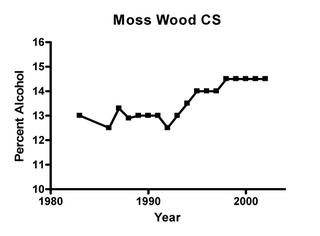Has there been an increase in alcohol levels in recent years? Unless you have access to the technical information on individual wines going back several decades it is hard to determine the changing fortunes of alcohol levels. Added to this is the fact that most wineries do not archive technical data for their wines on their web sites.
But there are some exceptions. Penfold’s does keep archived notes on its flagship Grange all the way back to the first (experimental) vintage of 1951. A graph of the alcohol levels in Grange seems to bounce all over the place, unless you consider the tenures of the winemakers. Grange owes its origins to Max Schubert who was Chief Winemaker at Penfold’s until 1974. Schubert kept alcohol levels at 13.5% or below. On close inspection he seems to have been trying to reduce alcohol over time, and only the 1951, 1954, 1963, 1965 and 1966 vintages were above 13%. When Don Ditter took over in 1975 alcohol levels jumped up to 14% but then progressively fell until 1980 when they again increased and the first 14.5% wine was made in 1984. John Duval began to make the wine in 1986 and he seemed content to maintain alcohol at 13.5% until the last few years of his tenure when 14.5% was reached again. Peter Gago took over in 1998 and has kept things at around 14%. Breaking alcohol levels down to how many vintages/decade were greater than 13% reveals that there were two in the 1950’s (’51 and ’54), three in the 1960s (’63, ‘65’ and ‘66), four in the 1970s (’75, ’76, ’77 and ’78), eight in the 1980s (all but ’80 and ’81), and all wines in 1990’s were above 13%. Is this evidence of increasing alcohol levels? It appears so, especially if you consider the period from 1970 onwards.

What about another wine? Moss Wood in the Margaret River Wine region of Western Australia makes one of the better Australian Cabernet Sauvignon wines. The first vintage was in 1973, but archived notes only go back as far as 1983. The data on alcohol levels in the Moss Wood Cabernet Sauvignon indicate a very clear increase in alcohol levels over the period 1983-2002.

While this is not a big sample of Australian wines, it does suggest that alcohol levels in two of Australia’s premium wines have been increasing over the last 20-30 years.
No comments:
Post a Comment